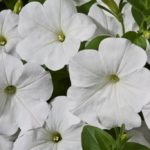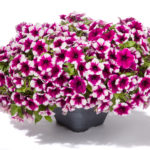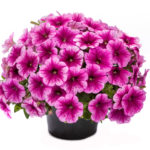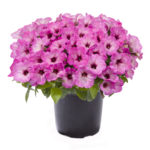- Mix
- Pink Star
- Purple Skirt
- Blue
- Blue Ice
- Grape Ice
- Nightlife
- Rose
- White
- Yellow
- Purple Splash
- Red
- Grape Ice
- Strawberry Flash
- Flamingo
- Grape Ice
- Purple
- Purple Skirt
- Flamingo
- Blue Star
- Pink Flash
- Pink Flash
- Blue Denim
- Mustard
Series: Petunia Good and Plenty®
Recommended Container: Pots, Hanging Baskets, Combination pots.
Consumer Uses: Flowering pots and baskets, mixed containers and window boxes, landscape plant for full sun.
Crop Planning from cell pack:
Pot Size Plants per pot (pp) Finish Time (weeks)
4” pot (10 cm) 1 pp 4 to 6
6” pot (15 cm) 1 pp 5 to 7
6” pot (15 cm) 2 pp 4 to 6
8 to 10” pots (20 to 25 cm) 3 to 4 pp 8 to 10
Temperature Requirement:
Day – 60° to 70°F (15° to 21°C)
Night – 55° to 60°F (13° to 15°C)
Media and pH Requirements: Use a sterile, well-drained soil with a pH range of 5.5 to 6.0. Water thoroughly and let soil dry out between irrigations. Over watering, oxygen deprivation, and poor drained soils may cause foliar chlorosis similar to chlorosis symptoms caused by iron deficiency.
Fertilizer requirements: Use a balanced feed at 200 to 250 ppm. EC of 1.25 to 2.0 is optimal. Chlorotic foliage frequently results from deficiencies of Fe, Mn, and Mg. Iron and Manganese will be seen on youngest leaves where as Magnesium will be seen on oldest leaves, both portrayed as interveinal chlorosis. To avoid the yellowing, ensure that fertilizer sources contain these elements or provide supplemental forms in your fertilizer including micro elements.
Pinching requirements: Pinch dominant shoots 10 to 14 days after transplant or once the plants have become established.
Plant Growth Regulators: B-9 is effective to control stretch during cloudy weather and for toning finished pots for improved shelf life. Sumagic PGR as spray at 15 to 30 ppm OR Bonzi as drench at 1 to 3 ppm for finishing.
Disease and Insect Pests: Whitefly, Thrip and Aphids
Pythium and Botrytis- Excessive moisture for long periods of time will damage roots, causing yellowing of plants resembling a nutrient deficiency. Maintain consistent soil moisture and regularly apply preventative root rot fungicides.
Comments: Mounding spreading habit and a day neutral flower response enables grower to sell in bloom in many size pots.

























